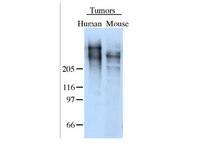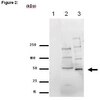Renal stromal miRNAs are required for normal nephrogenesis and glomerular mesangial survival.
Phua, YL; Chu, JY; Marrone, AK; Bodnar, AJ; Sims-Lucas, S; Ho, J
Physiological reports
3
2015
Pokaż streszczenie
MicroRNAs are small noncoding RNAs that post-transcriptionally regulate mRNA levels. While previous studies have demonstrated that miRNAs are indispensable in the nephron progenitor and ureteric bud lineage, little is understood about stromal miRNAs during kidney development. The renal stroma (marked by expression of FoxD1) gives rise to the renal interstitium, a subset of peritubular capillaries, and multiple supportive vascular cell types including pericytes and the glomerular mesangium. In this study, we generated FoxD1(GC);Dicer(fl/fl) transgenic mice that lack miRNA biogenesis in the FoxD1 lineage. Loss of Dicer activity resulted in multifaceted renal anomalies including perturbed nephrogenesis, expansion of nephron progenitors, decreased renin-expressing cells, fewer smooth muscle afferent arterioles, and progressive mesangial cell loss in mature glomeruli. Although the initial lineage specification of FoxD1(+) stroma was not perturbed, both the glomerular mesangium and renal interstitium exhibited ectopic apoptosis, which was associated with increased expression of Bcl2l11 (Bim) and p53 effector genes (Bax, Trp53inp1, Jun, Cdkn1a, Mmp2, and Arid3a). Using a combination of high-throughput miRNA profiling of the FoxD1(+)-derived cells and mRNA profiling of differentially expressed transcripts in FoxD1(GC);Dicer(fl/fl) kidneys, at least 72 miRNA:mRNA target interactions were identified to be suppressive of the apoptotic program. Together, the results support an indispensable role for stromal miRNAs in the regulation of apoptosis during kidney development. | | | 26438731
 |
Ablation of the renal stroma defines its critical role in nephron progenitor and vasculature patterning.
Hum, S; Rymer, C; Schaefer, C; Bushnell, D; Sims-Lucas, S
PloS one
9
e88400
2014
Pokaż streszczenie
The renal stroma is an embryonic cell population located in the cortex that provides a structural framework as well as a source of endothelial progenitors for the developing kidney. The exact role of the renal stroma in normal kidney development hasn't been clearly defined. However, previous studies have shown that the genetic deletion of Foxd1, a renal stroma specific gene, leads to severe kidney malformations confirming the importance of stroma in normal kidney development. This study further investigates the role of renal stroma by ablating Foxd1-derived stroma cells themselves and observing the response of the remaining cell populations. A Foxd1cre (renal stroma specific) mouse was crossed with a diphtheria toxin mouse (DTA) to specifically induce apoptosis in stromal cells. Histological examination of kidneys at embryonic day 13.5-18.5 showed a lack of stromal tissue, mispatterning of renal structures, and dysplastic and/or fused horseshoe kidneys. Immunofluorescence staining of nephron progenitors, vasculature, ureteric epithelium, differentiated nephron progenitors, and vascular supportive cells revealed that mutants had thickened nephron progenitor caps, cortical regions devoid of nephron progenitors, aberrant vessel patterning and thickening, ureteric branching defects and migration of differentiated nephron structures into the medulla. The similarities between the renal deformities caused by Foxd1 genetic knockout and Foxd1DTA mouse models reveal the importance of Foxd1 in mediating and maintaining the functional integrity of the renal stroma. | | | 24505489
 |
The effects of tenascin C knockdown on trabecular meshwork outflow resistance.
Keller, KE; Vranka, JA; Haddadin, RI; Kang, MH; Oh, DJ; Rhee, DJ; Yang, YF; Sun, YY; Kelley, MJ; Acott, TS
Investigative ophthalmology & visual science
54
5613-23
2013
Pokaż streszczenie
Tenascin C (TNC) is a matricellular glycoprotein whose expression in adult tissue is indicative of tissue remodeling. The purpose of the current study was to determine the localization of TNC in trabecular meshwork (TM) tissue and to analyze the effects of TNC on intraocular pressure (IOP).Human TM frontal sections were immunostained with anti-TNC and imaged by confocal microscopy. TNC mRNA and protein levels were quantitated in anterior segments perfused at physiological and elevated pressure. Short, hairpin RNA (shRNA) silencing lentivirus targeting full-length TNC (shTNC) was applied to anterior segment perfusion organ cultures. The IOPs and central corneal thickness (CCT) of wild-type, TNC(-/-), and tenascin X (TNX(-/-)) knockout mice were measured.TNC was distributed in the juxtacanalicular (JCT) region of adult human TM, predominantly in the basement membrane underlying the inner wall of Schlemm's canal. Application of shTNC lentivirus to human and porcine anterior segments in perfusion culture did not significantly affect outflow rate. Although TNC was upregulated in response to pressure, there was no difference in outflow rate when shTNC-silenced anterior segments were subjected to elevated pressure. Furthermore, IOPs and CCTs were not significantly different between TNC(-/-) or TNX(-/-) and wild-type mice.TNC does not appear to contribute directly to outflow resistance. However, TNC immunolocalization in the JCT of adult human eyes suggests that certain areas of the TM are being continuously remodeled with or without an IOP increase. | Immunohistochemistry | | 23882691
 |
Loss of caveolin-1 from bronchial epithelial cells and monocytes in human subjects with asthma.
Bains, SN; Tourkina, E; Atkinson, C; Joseph, K; Tholanikunnel, B; Chu, HW; Riemer, EC; Martin, R; Hoffman, S
Allergy
67
1601-4
2011
Pokaż streszczenie
Caveolin-1 has emerged as a critical regulator of signaling pathways involved in lung fibrosis and inflammation.Therefore, we investigated whether caveolin-1 is deficient in asthmatic patients and in a murine model of asthma.Immunohistochemical analyses of endobronchial biopsies showed a remarkable loss of caveolin-1 in the lungs of asthmatic patients compared with controls. This loss was most evident in bronchial epithelial cells and associated with an increase in the expression of extracellular matrix proteins: collagen I, tenascin, and periostin. Cultured primary bronchial epithelial cells of asthmatics had lower caveolin-1 expression compared with control cells. In addition, caveolin-1 expression was significantly decreased in peripheral blood monocytes from asthma patients. The loss of caveolin-1 was also observed in a mouse model for asthma (mice sensitized and challenged with aspergillus fumigatus).To our knowledge, this is the first demonstration that the regulatory protein caveolin-1 is reduced in patients with asthma. | | | 23004679
 |
Neuronal replacement in the injured olfactory bulb.
Liu, H; Guthrie, KM
Experimental neurology
228
270-82
2010
Pokaż streszczenie
The adult forebrain subventricular zone contains neural stem cells that produce neurons destined for the olfactory bulb, where interneuron populations turnover throughout life. Forebrain injuries can stimulate production of these cells, and re-direct migrating precursors from the olfactory system to areas of damage, where their region-appropriate differentiation and long-term functional integration remain a matter for debate. Paradoxically, little is known about the ability of these progenitors to replace olfactory neurons lost to injury. Their innate capacity to generate bulb neurons may give them an advantage in this regard, and using injections of N-methyl-d-aspartate to kill mature olfactory bulb neurons, combined with bromodeoxyuridine labeling to monitor the fate of adult-born cells, we investigated the potential for injury-induced neurogenesis in this system. Widespread degeneration of bulb neurons did not affect the rate of cell proliferation in the subventricular zone, or cause neuroblasts to divert from their normal migratory route. However migration was slowed by the injury, leading to the accumulation and differentiation of neuroblasts as NeuN+ cells in the rostral migratory stream within 2 weeks of their birth. Despite this, a subset of new neurons successfully invaded the damaged bulb tissue, where they expressed neuronal markers including NeuN, calretinin, GABA, and tyrosine hydroxylase, with some surviving here for as long as 6 months. To test for functional integration of cells born post-injury, we also performed smaller NMDA lesions in restricted portions of the bulb granule cell layer and observed adult-born NeuN+ cells in these areas within 5 weeks, and BrdU+ cells that expressed the immediate-early gene c-fos following odor stimulation. These data suggest that the normal neurogenic capacity of the adult subventricular zone can be adapted to replace subsets of olfactory neurons lost to injury. | Immunohistochemistry | Mouse | 21310147
 |
Antifibrotic properties of caveolin-1 scaffolding domain in vitro and in vivo.
Tourkina, E; Richard, M; Gööz, P; Bonner, M; Pannu, J; Harley, R; Bernatchez, PN; Sessa, WC; Silver, RM; Hoffman, S
American journal of physiology. Lung cellular and molecular physiology
294
L843-61
2008
Pokaż streszczenie
Lung fibrosis involves the overexpression of ECM proteins, primarily collagen, by alpha-smooth muscle actin (ASMA)-positive cells. Caveolin-1 is a master regulator of collagen expression by cultured lung fibroblasts and of lung fibrosis in vivo. A peptide equivalent to the caveolin-1 scaffolding domain (CSD peptide) inhibits collagen and tenascin-C expression by normal lung fibroblasts (NLF) and fibroblasts from the fibrotic lungs of scleroderma patients (SLF). CSD peptide inhibits ASMA expression in SLF but not NLF. Similar inhibition of collagen, tenascin-C, and ASMA expression was also observed when caveolin-1 expression was upregulated using adenovirus. These observations suggest that the low caveolin-1 levels in SLF cause their overexpression of collagen, tenascin-C, and ASMA. In mechanistic studies, MEK, ERK, JNK, and Akt were hyperactivated in SLF, and CSD peptide inhibited their activation and altered their subcellular localization. These studies and experiments using kinase inhibitors suggest many differences between NLF and SLF in signaling cascades. To validate these data, we determined that the alterations in signaling molecule activation observed in SLF also occur in fibrotic lung tissue from scleroderma patients and in mice with bleomycin-induced lung fibrosis. Finally, we demonstrated that systemic administration of CSD peptide to bleomycin-treated mice blocks epithelial cell apoptosis, inflammatory cell infiltration, and changes in tissue morphology as well as signaling molecule activation and collagen, tenascin-C, and ASMA expression associated with lung fibrosis. CSD peptide may be a prototype for novel treatments for human lung fibrosis that act, in part, by inhibiting the expression of ASMA and ECM proteins. | | | 18203815
 |


















